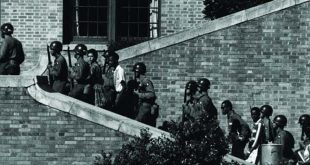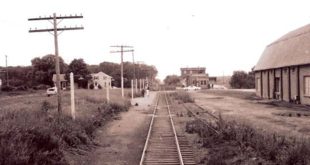Went up to Harlem last week for a farewell drink, a double bourbon, neat, at the Lenox Lounge up on Malcolm “X” Boulevard, once called Lenox Avenue, just south of 125th Street. The joint closed on December 31, and a part of old Harlem died. Imagine closing Tri Šešira in Skadarlija.
The Lenox Lounge was a hangout for Billie Holliday, Miles Davis and Malcolm “X”, the American black revolutionary. It sparkled with Art Deco neon lights and shining aluminum siding. James Baldwin [of Go Tell it on the Mountain, The Amen Corner and Blues for Mr. Charlie fame] and Langston Hughes [Tambourines toGlory, The Weary Blues] used to lunch there, while Ella Fitzgerald sang for her supper. They say a white guy who bought the joint is going to reopen. But it won’t be the same.
Harlem ain’t what it used to be, or what you imagine it to be. Harlem, New York’s once mainly black enclave, has gone through many reincarnations but the one fixed in memory was where African-American jazz era élan sparkled with rhinestones, what the hip-hop generation now calls “bling”. “It don’t mean a thing, if you ain’t got that swing.” It was peopled by iconic performers and black nobility, Count Basie, Duke Ellington, Cab Calloway, Ella Fitzgerald, Ethel Waters and Josephine Baker.
 125th Street, Harlem’s main drag, never had any gems except for the Appollo Theatre. It never was and never will be Harlem. Yesterday’s record stores, pawnshops, bodegas and liquors stores have given way to fast foods joints and down scale department stores including one called the “Gem”, which is anything but. Street peddlers hawk vile smelling incense and hip-hop CD’s. Offers to braid your hair or indulge in any number sexual activities abound. “Sons of Israel”, a religion of sorts, in bedraggled costumes held up by grimy red and white sashes glower at you in front of their ramshackle Temple. You have to get off that God forsaken street to experience the real Harlem, then and now.
125th Street, Harlem’s main drag, never had any gems except for the Appollo Theatre. It never was and never will be Harlem. Yesterday’s record stores, pawnshops, bodegas and liquors stores have given way to fast foods joints and down scale department stores including one called the “Gem”, which is anything but. Street peddlers hawk vile smelling incense and hip-hop CD’s. Offers to braid your hair or indulge in any number sexual activities abound. “Sons of Israel”, a religion of sorts, in bedraggled costumes held up by grimy red and white sashes glower at you in front of their ramshackle Temple. You have to get off that God forsaken street to experience the real Harlem, then and now.
During the heyday of the first Harlem Renaissance of the 20’s and 30’s, putting aside the literary, artistic and theatrical achievements that have filled volumes, it was the “allure of its enormous social fluidity” of this “urban free zone” that drew integrated crowds to Harlem and made things happen. Anything goes and went, so it’s said. Racism was constant but it was tolerated and benign. The block between Lenox and Seventh Avenues on 133rd Street teemed with the “densest aggregation of nightclubs and cabarets in New York.” Then it was called “Jungle Alley”, surely a derogatory racist slight, but used in an amiable and friendly way, not in the least mean, or so it seemed.
 The best known were the Cotton Club, Connie’s Inn and Small’s Paradise. Obviously I wasn’t part of that original Renaissance. I am old, but not that old. I came in on the tail end, the late 50’s and the early 60’s. The Cotton Club and Connie’s Inn were long gone. One of the bars we frequented was the West End, home of the beat poets Allen Ginsberg and Jack Kerouac and Vietnam War protesters, on Broadway and 114th Street across from Columbia University, a hop, skip and jump away from Small’s on Seventh Avenue [now Adam Clayton Powell, Jr. Boulevard] and 135th Street.
The best known were the Cotton Club, Connie’s Inn and Small’s Paradise. Obviously I wasn’t part of that original Renaissance. I am old, but not that old. I came in on the tail end, the late 50’s and the early 60’s. The Cotton Club and Connie’s Inn were long gone. One of the bars we frequented was the West End, home of the beat poets Allen Ginsberg and Jack Kerouac and Vietnam War protesters, on Broadway and 114th Street across from Columbia University, a hop, skip and jump away from Small’s on Seventh Avenue [now Adam Clayton Powell, Jr. Boulevard] and 135th Street.
So we went. The music, the scene was exhilarating, liberating; the girls, gorgeous, easy and exotic; the pot prime, cheap and available; the food great in those all night diners under the El Train that mirrored the paintings of Edward Hopper. It wasn’t as elegant or historical as it once was but it was the next best thing around. It had more jazz and more energy than the tame by comparison coffee houses in Greenwich Village, the Café Au Go Go, Le Figaro, The Bitter End or the Fat Black Pussy Cat.
Then the music died and blight descended. The July, 1964 the shooting of a black teenager by a white police officer started the Harlem riots ending in looting and burning. I remember walking with my African American girl friend on New Year’s Eve to the New York Central railroad station on 125th Street and Park Avenue in fear. The blackout of 1977 sparked more violence and destruction. Back then you avoided driving through Harlem and, when you did you rolled up your windows. I gladly paid the toll on the Triborough Bridge to avoid Harlem coming home from Connecticut weekends.
But the once black and bleak Harlem is now a multi colored and multi ethnic Phoenix, risen from its ashes.
The Red Rooster, a new restaurant, crows on Lenox Avenue. It’s hard by hardscrabble dingy 125th Street but a world and a continent away. It’s a down home southern bistro, decorated with mid century American collectible boasting a library of African American books, presided over by Marcus Samuelsson, a black Ethiopian born chef adopted by and renamed by Swedes. The place is visited by svelte Russian models and other exotic European types, and visited by people just like you and me, enjoying the food and the day.
Next door is Sylvia’s, another landmark restaurant still serving “soul food”, where politicians of all stripes, including Bill Clinton and Nelson Mandela, often hold court and pontificate proving, they think, they are part of the hoi polloi. Sylvia Wood, the owner died last July but the beat goes on with her daughter now in charge.
Across the street is the Patisserie des Ambassades a Senegalese French pastry shop. The Lenox Lounge was a block away
There are literally dozens of blocks of meticulously renovated brownstones, those uniquely New York row houses lining tree shaded streets, elegant stoops reaching up to brass enhanced mahogany doors. The Astor Row houses built by John Jacob Astor and his grandson in 1883 with their wooden porches evoking Savannah, Georgia sparkle. Striver’s Row brownstones built in 1893 emulate Governor Oglethorpe’s Savannah, Georgia urban plan and evoke luxury past.
 Just a few years ago these million dollar properties that rival those down on Manhattan’s Upper East Side were derelict slums. There are a lot of white faces in this once all black neighborhood. Mercedes and Audis are now parked at the curb.
Just a few years ago these million dollar properties that rival those down on Manhattan’s Upper East Side were derelict slums. There are a lot of white faces in this once all black neighborhood. Mercedes and Audis are now parked at the curb.
Rising among these historic beauties are gleaming new glass and metal buildings housing apartments and museums replete with sidewalk sculptures and urban art. Makes you want to revisit Harlem.
Deyan Ranko Brashich, an attorney, Op-Ed columnist, resides in New York City. “Letters from America,” a collection of essays, will be published January, 2013. His contact and blog “Contrary Views” is at www.deyanbrashich.com.
 Печат – Лист слободне Србије Политички недељник, актуелна политичка дешавања, друштво, свет, култура.
Печат – Лист слободне Србије Политички недељник, актуелна политичка дешавања, друштво, свет, култура.








Ja nisam amerikanka i za mene nostalgija za tamo nestalim Harlemom, je prilicno neinteresantna tema. Clanak i nije lose napisan, pisac se trudi da to bude na knjizevnom nivou, ali ne dotice me ni malo ta americka nostalgija. Jako sam daleko od njegovih osecaja i pogleda na njihov zivot. Sta je cilj urednika sa postavljenjem ovog amerikanca na stranice Pecata? Za mene, nije lose, ali i ne treba.